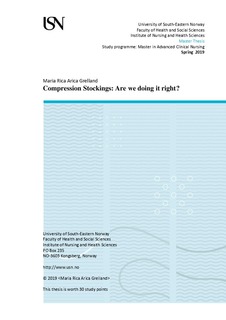Compression Stockings: Are we doing it right?
Master thesis
Permanent lenke
http://hdl.handle.net/11250/2629178Utgivelsesdato
2019Metadata
Vis full innførselSamlinger
Sammendrag
The word’s population is ageing. Life expectancy has been in a rapid rise in the past decades and the world is facing a tremendous challenge with an increasing elderly population. Norway alone is expecting 1.3 millions of old people (> 70 years) in the year 2060. With an advancing age the risk of arterial and venous diseases also increases. These means an increasing demand in compression stockings therapy, as it is the golden standard in treating venous leg ulcers. But one major pitfall in compression therapy is prescribing to a patient with reduced blood flow in the limb due to medical condition called peripheral arterial disease (PAD) and this mistake can be avoided if Ankle Brachial Index (ABI) assessment is done prior to initiation of compression stockings. Modern medical technologies are continuously emerging but ABI procedure with the use of Doppler ultrasound still remain the corner stone in diagnosing PAD. The Ankle Brachial Index procedure has high accuracy with over 50 % rating in detecting serious ischemia. ABI assessment plays an important role in compression stocking therapy for the reason that this procedure detects PAD.
Currently, Norwegian’s primary health care guiding principles in prescribing compression stockings is the present of palpable pulses in the feet and ankles. This clinical practice is in contrast compared to other countries where ABI was integrated in the protocol and the result of the assessment determines the requirements of compression stockings. This study will try to investigate the use of ABI in compression stockings through literature review. Systematic literature search was made in major medical and health data bases for the period of 1995 to 2018 which yielded sixteen relevant articles. Thematic analysis was chosen as a method for analysing and summarizing the evidence. Preferred Reporting Items for Systematic reviews and Meta analysis (PRISMA) statement was utilized to serve as a guide in complying and demonstrating the review.The results of this review revealed that there was a wide variation of practice existing in this particular area and the knowledge and skills was relatively low among health care professionals. These statements were supported by a number of researchers in the identified literature. In addition it also identified the role Ankle Brachial Index in compression stockings therapy. Furthermore, some researcher in the literature suggested that policy regarding prescribing compression stockings needed to be scrutinized in order to foster safe and quality care to the patients in this particular field.Analysis of the literature identified two main themes. The first theme is “ABI as a clinical tool”, and the benefits and significance of ABI procedure in compression stocking therapy was elaborated in this theme. The second theme was “Pillars of success”, and the results of the review pointed out that in order to succeed in venous leg ulcers and compression stockings therapy, primary health care must go through the four pillars of success which were discussed further in this theme.
Another important issue identified in this review was the role of Nurse Practitioners in wound treatment and compression therapy. An expert claimed that with their competence and authority, there is a better chance in giving holistic care to the patient. Nurse Practitioner’s role is an emerging in Nordic countries, understanding their clinical capacity is essential in establishing the new role of Nurse Practitioner in Norway and might be one of the solutions to the problem that primary health care is facing today and the in the future.
As the aim of this review was primarily to explore the literature about the use of ABI in compression stockings, it had also an opportunity to explore evidence based practice (EBP) within this area which hopefully will provide the reader with wider insights in this particular field. The author also desires that by reading this review it will encouraged the reader to reflect and self evaluate their clinical practice in this particular field of science.
